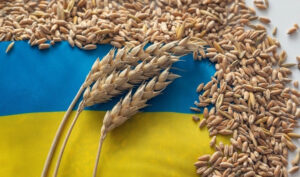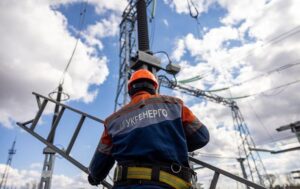
Ukraine’s agricultural sector made a significant breakthrough in development in 2010-2021, employing 17% of Ukrainians and generating 19% of GDP, while 70% of its products are exported, which is one of the highest rates in Europe, said Acting Minister of Agrarian Policy and Food Taras Vysotsky.
According to him, Ukraine’s production is enough to feed almost 400 million people.
“Ukraine’s role in international food security is very important. After the full-scale invasion of the aggressor country, Ukraine was unable to export its products for four months. This led to a 35% increase in the global food price index in 2022. In African countries, hundreds of millions of people were forced to significantly reduce their food consumption,” the press service of the Ministry of Agrarian Policy and Food quoted Vysotsky as saying in his speech at the national educational and professional course for young people ”State Builder: the Way to Restore the State.”
Vysotsky noted that Ukraine has traditionally exported grains and oilseeds and many other products. In particular, Ukraine ranks 4th in the world in corn exports, and first in sunflower oil. In addition, it ranks 7th in poultry exports. Ukrainian dairy farmers are among the top ten exporters of butter. In addition, Ukraine ranks 4th in walnut production and is one of the world’s leading exporters of honey.

On August 19, Foxtrot, an omnichannel electronics and home appliances retailer, opened a renovated store in the Hermes shopping center in Bila Tserkva, Kyiv region.
According to the company’s press service on Monday, the area of the outlet has not changed (total area – 1.5 thousand square meters, selling area – 1.2 thousand square meters), while the number of goods in the store was increased due to redevelopment.
The renovated store also has a service for customers with hearing impairments.
As reported, the retailer’s plan for 2024 envisages opening 10 new and renovated stores.
“Foxtrot is one of the largest omnichannel retail chains in Ukraine in terms of the number of stores and sales of electronics and household appliances. As of August 2024, the retailer operates 122 stores in 66 cities of Ukraine, including the frontline cities of Kherson, Kramatorsk and Sloviansk, an online platform foxtrot.ua and a mobile application of the same name.
The Foxtrot brand is developed by the Foxtrot group of companies. The co-founders are Valery Makovetsky and Gennady Vykhodtsev.

According to preliminary information, NPC Ukrenergo plans to impose electricity restrictions for the regions on Tuesday, August 27, followed by hourly blackouts throughout the day, DTEK reported on Telegram.
In particular, from 00:00 to 06:00, it is planned to apply three rounds of blackouts, from 06:00 to 11:00 – four, from 11:00 to 15:00 – three, from 15:00 to 21:00 – four, from 21:00 to 00:00 – three.
“There is a high probability of using light gray outage zones in the schedules,” the company said.

The Lithuanian government has extended the temporary residence permit in Lithuania for Ukrainian residents who fled the war, LRT reports.
“Previously, this protection was established until March 2025. The government has extended the temporary protection until March 4, 2026. This means that it will be possible to issue temporary residence permits that will be valid until that date,” the report said.
According to the Department of Migration, 30-40 new applications for a temporary residence permit in Lithuania are registered daily. Currently, more than 44.3 thousand people have a valid residence permit in Lithuania on the basis of temporary protection.
According to the Minister of the Interior, Agne Bilotaite, the extension of the deadline will allow Ukrainians to reduce the administrative burden, as they will have a residence permit valid for a longer period of time.
The extension of this period was proposed on the basis of the relevant decision of the European Union (EU) adopted in June this year.
The temporary protection mechanism at the EU level was activated on March 4, 2022, shortly after Russian troops invaded Ukraine.

More than 34 thousand wage arrears were registered as of August 6, 2024, according to the Ministry of Justice. Almost 2 thousand companies turned out to be debtors. The largest number of such businesses is in Sumy region, and the smallest – in Chernivtsi region. Debts decreased at the beginning of the full-scale campaign, but this year more new proceedings have been opened than in the whole of 2023.
The largest number of proceedings on wage arrears was registered in 2021 – 6.3 thousand. After the start of the full-scale invasion, new proceedings decreased by 29%. Last year, their number began to grow: +6.6% per year. This year, companies have already owed their employees 7.1% more than in the whole of last year.
1,872 companies that owe salaries to employees. Most of these employers were found in Sumy region – 5.6 thousand proceedings or 16.4% of the total. Kyiv follows with 3.4 thousand wage arrears (9.8%). Dnipropetrovs’k region rounds out the top three – 2.2 thousand or 6.6%.
It is worth noting that in almost 3 thousand proceedings, the region is not identified.
Among the organizational and legal forms, the largest debtors are state-owned enterprises and joint-stock companies – more than 11 thousand and 9 thousand proceedings, or 33.8% and 28.8% of all debts, respectively. LLCs are in third place – 4.9 thousand or 14.2%. Subsidiaries and municipal enterprises account for 12.5% and 4.3% of all debts.
It is worth noting that various subsidiaries of Oblavtodor account for 9.7% of the total number of wage arrears: 3.3 thousand proceedings. Only the Sumy Machine-Building Research and Production Association owes its employees more money – 4,071 proceedings or 11.8% of the total.
The most persistent debtors among Ukrainian companies are:
– Sumy Machine-Building Research and Production Association – 4,071 proceedings
– Poltava Oblavtodor – 1079 proceedings
– Nizhyn Engineering Armament Repair Plant – 1038 proceedings
– Sumy Machine-Building Research and Production Association – engineering – 892 proceedings
– Energostal – 876 proceedings
– Zaporizhtsivilproekt – 610 proceedings
– Rivne Automobile Repair Plant – 508 proceedings




The share of the yuan in international settlements reached a record 4.74% in July, up from 4.61% in June, Securities Daily reports, citing data from the SWIFT settlement system.
The yuan has been the fourth most popular currency for international payments for the ninth month in a row.
In the trade sector, the Chinese currency has a market share of 6% and is second only to the US dollar, outperforming the euro for the second month in a row.
The popularity of the yuan is due to the growth of trade, stable macroeconomic indicators and greater openness of the country’s financial market, said Chao Zhen, a researcher at the Hainan Institute of Financial Studies at the People’s Bank of China.